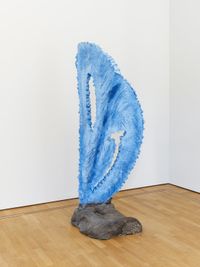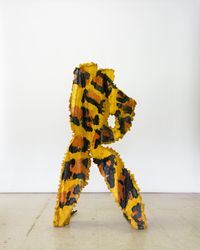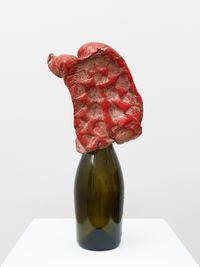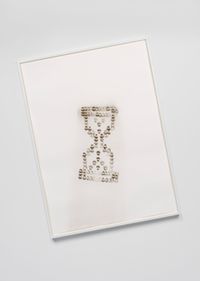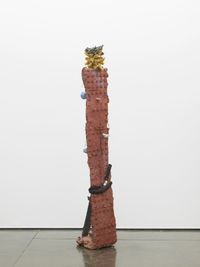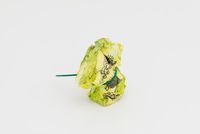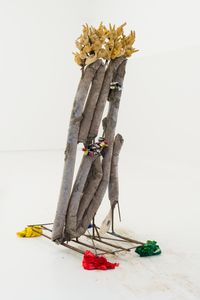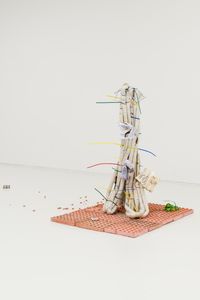Michael Dean (b. 1977, Newcastle Upon Tyne) lives and works in London.
Read MoreIn 2016, Dean was a Turner Prize nominee and in 2018 was nominated for the Hepworth Prize for Sculpture. In 2019, Dean will have a solo shows at Museo Rufino Tamayo, Mexico City and at S.M.A.K., Ghent, Belgium, and participate in a group show at Palais des Beaux- Arts, Paris.
Recent solo shows include: Michael Dean: Laughing for Crying, St Carthage Hall, Lismore Castle Arts, Lismore (2019); Contemporary Sculpture: Sam Anderson & Michael Dean, Boca Raton Museum of Art, Florida, US (two-person with Sam Anderson, 2019); Having you on, BALTIC Centre for Contemporary Art, Gateshead (2018); ShanghArt Gallery, Shanghai (2018); Four Fucksakes, Herald St | Museum St, London (2017); Teaxths and Angeruage, Portikus, Frankfurt (2017); Lost True Leaves, Nasher Sculpture Center, Dallas (2016); Sic Glyphs, South London Gallery, London (2016); Stamen Papers, Fondazione Giuliani, Rome (2016); Qualities of Violence, De Appel Arts Centre, Amsterdam (2015); Jumping Bones, Extra City Kunsthal, Antwerp (2015); HA HA HA HA HA HA, Kunst Forum Ludwig, Aachen (2014); The Introduction of the Muscle, Arnolfini, Bristol (2013); Cubitt, London (2012); Henry Moore Institute, Leeds (2012); Kunstverein Freiburg, Freiburg (2011); Serpentine Gallery Pavilion, London (2011) and Nomas Foundation, Rome (2010).
Group shows include: Summer Exhibition 2019, Royal Academy of Art, London (2019), Scripts, Bielefelder Kunstverein, Bielefeld (2018); Give Up The Ghost, Baltic Triennial 13, Tallinn Art Hall, Tallinn (2018); Hepworth Prize for Sculpture 2018, The Hepworth Wakefield, Wakefield (2018); Raymond, Manifesta 12, Grand Hotel et Des Palmes, Palermo (2018); Alexandra Bircken, Josh Brand, Matthew Darbyshire, Michael Dean, Cary Kwok, Amalia Pica, Nicole Wermers, Herald St | Museum St, London (2018); Against The Wall?, S.M.A.K., Ghent (2018); Skulptur Projekte, Münster (2017); More Than Just Words [On the Poetic], Kunsthalle Wien, Vienna (2017); Zeno X Gallery, Antwerp (2017); Turner Prize 2016, Tate Britain, London (2016); Pierre Guyotat: La matière de nos œuvres, Galerie Azzedine Alaïa, Paris (2016); Pure Fiction, Marian Goodman Gallery, Paris (2016); Concrete Islands, Kayne Griffin Corcoran, Los Angeles (2016); House of Commons, Portikus, Frankfurt (2016); The Language of Things, Public Art Fund - City Hall Park, New York (2016); Par tibi, Roma, nihil, Nomas Foundation, Rome (2016); Albert the Kid Is Ghosting, David Roberts Art Foundation, London (2015); Sculptures Also Die, curated by Lorenzo Benedetti, CCC Strozzina, Florence (2015); The Noing Uv It, Bergen Kunsthall, Bergen (2014); MIRRORCITY, curated by Stephanie Rosenthal, Hayward Gallery, London (2014); Manners of Matter, curated by Chris Sharp, Salzburger Kunstverein, Salzburg (2014); Thousand Doors, curated by Iwona Blazwick, Whitechapel at The Gennadius Library, Athens (2014); A History of Inspiration, curated by Adnan Lyildiz, Palais de Tokyo, Paris (2013); A Dying Artist, Institute of Contemporary Arts, London (2011); Beyond the Fragile Geometry of Sculpture, curated by Lorenzo Benedetti, De Vleeshal, Middelburg (2011); We Will Live, We Will See, curated by Pavel S. Pys, Zabludowicz Collection, London (2011) and Sculpture Also Dies, curated by Lorenzo Benedetti, Kunsthalle Mulhouse, Mulhouse (2010).
Text courtesy Herald St.
